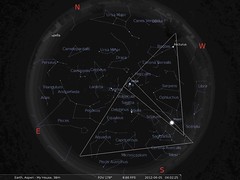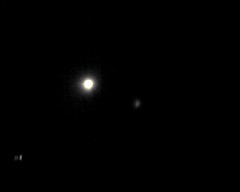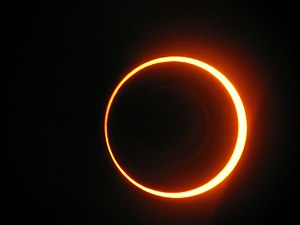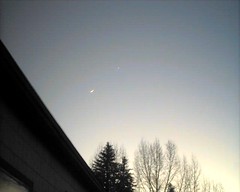I was on a mission to log my first April Aspen Astronomy viewing and I had the
Eta Aquarid meteor shower in my sights – I thought.
I read that this might not be an easy phenomenon to view due to the timing of the April, 2012 Supermoon, but I decided to give it a try anyway and I performed the preliminary research.
First, I had to learn how to find Aquarius, so I decided to try out a computer application called Stellarium that I discovered via a tweet from
@kimKomando (I love
Google Reader).
FINDING AQUARIUS IN ASPEN IN APRIL USING
STELLARIUM:
Here’s what I found in the Stellarium view (I added the white triangles for this post):
 Stellarium: Aquarius & Supermoon - Aspen, Colorado (Photo credit: richpalpine)
Stellarium: Aquarius & Supermoon - Aspen, Colorado (Photo credit: richpalpine)
I looked like
Vega, the Moon, and Aquarius made a more or less equilateral triangle in the south-southeastern sky so I thought this would help me find the water-bearing zodiacal constellation and therefore the Aquarid meteor shower.
First, I would have to find Vega. Upon looking at the Stellarium chart again, it appeared that on April 6
th, Vega, the Moon and
Arcturus would make a sideways equilateral triangle in the west-southwestern sky. I already knew how to use the
Big Dipper to find Arcturus
(“Arc to Arcturus”), and of course the Supermoon would be obvious.
This was great! Thanks to Stellarium, I was all ready to find Aquarius. Unfortunately though, as predicted, I not only found it difficult to rouse myself at 4:00 AM, (I did make a short, feeble attempt), but the strong super-moonlight, made it difficult even to find Aquarius itself, let alone the meteor shower. I did not see the Aquarids.
Despite this setback, I did use my binoculars to view our spectacular Moon. It was huge -- and very bright!
Its features were more visible than usual in some respects, but were actually somewhat obscured by the intensity of the reflected light itself. I also took some photos (once again with the old SiPix relic camera):
Supermoon - May 2012, Aspen, Colorado (Photos credit:
richpalpine)

In the end, I was a little disappointed in both the observation conditions
and in my effort, but I did benefit from the preliminary research, and I was able to log my first April, 2012, Aspen astronomy event. I had been rewarded by the fabulous sight of the Supermoon on Saturday night and again on Sunday morning!
The next major meteor shower is the
Perseid meteor shower, due
to be visible from July 23
rd-August 22
nd with the maximum occurring August 12
th/13
th from late night until dawn.
I hope I get to see it.
 Eclipse Anular (Photo credit: Wikipedia)
Eclipse Anular (Photo credit: Wikipedia)






